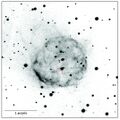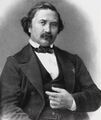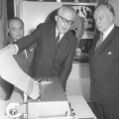Template:Selected anniversaries/March 11: Difference between revisions
No edit summary |
No edit summary |
||
| Line 4: | Line 4: | ||
||1636: Christoph Grienberger dies ... Jesuit astronomer, after whom the crater Gruemberger on the Moon is named. Pic: book cover. | ||1636: Christoph Grienberger dies ... Jesuit astronomer, after whom the crater Gruemberger on the Moon is named. Pic: book cover. | ||
File:Urbain Le Verrier.jpg|link=Urbain Le Verrier (nonfiction)|1811: Mathematician and astronomer [[Urbain Le Verrier (nonfiction)|Urbain Le Verrier]] born. | File:Urbain Le Verrier.jpg|link=Urbain Le Verrier (nonfiction)|1811: Mathematician and astronomer [[Urbain Le Verrier (nonfiction)|Urbain Le Verrier]] born. Le Verrier will predict the existence and position of Neptune using only mathematics, an event which will be widely regarded as one of the most remarkable moments of 19th century science. | ||
||1812: Philip James de Loutherbourg dies ... painter who became known for his large naval works, his elaborate set designs for London theatres, and his invention of a mechanical theatre called the "Eidophusikon". Pic. | ||1812: Philip James de Loutherbourg dies ... painter who became known for his large naval works, his elaborate set designs for London theatres, and his invention of a mechanical theatre called the "Eidophusikon". Pic. | ||
| Line 10: | Line 10: | ||
||1818: Chemist and academic Henri Étienne Sainte-Claire Deville born. Pic. | ||1818: Chemist and academic Henri Étienne Sainte-Claire Deville born. Pic. | ||
File:Joseph Bertrand.jpg|link=Joseph Bertrand (nonfiction)|1822: Mathematician, economist, and academic [[Joseph Bertrand (nonfiction)|Joseph Louis François Bertrand]] born. | File:Joseph Bertrand.jpg|link=Joseph Bertrand (nonfiction)|1822: Mathematician, economist, and academic [[Joseph Bertrand (nonfiction)|Joseph Louis François Bertrand]] born. Bertrand will contribute to number theory, differential geometry, probability theory, economics and thermodynamics. | ||
File:Niles Cartouchian and Anton Rhodomunde Confront Gnotilus.jpg|link=Niles Cartouchian and Anton Rhodomunde Confront Gnotilus|1823: Publication of ''[[Niles Cartouchian and Anton Rhodomunde Confront Gnotilus]]'' causes widespread debate about the role of private citizens in fighting [[crimes against mathematical constants]]. | File:Niles Cartouchian and Anton Rhodomunde Confront Gnotilus.jpg|link=Niles Cartouchian and Anton Rhodomunde Confront Gnotilus|1823: Publication of ''[[Niles Cartouchian and Anton Rhodomunde Confront Gnotilus]]'' causes widespread debate about the role of private citizens in fighting [[crimes against mathematical constants]]. | ||
| Line 20: | Line 20: | ||
||1879: Chemist Niels Bjerrum dies. He investigated the properties of electrolytic solutions in regards to their dissociation and association,, and introduced the quantity osmotic coefficient in relation to non-ideal solutions of electrolytes. He is known for the Bjerrum length. Pic search: https://www.google.com/search?q=niels+bjerrum | ||1879: Chemist Niels Bjerrum dies. He investigated the properties of electrolytic solutions in regards to their dissociation and association,, and introduced the quantity osmotic coefficient in relation to non-ideal solutions of electrolytes. He is known for the Bjerrum length. Pic search: https://www.google.com/search?q=niels+bjerrum | ||
File:Harry Laughlin.jpg|link=Harry H. Laughlin (nonfiction)|1880: American eugenicist and sociologist [[Harry H. Laughlin (nonfiction)|Harry H. Laughlin]] born. | File:Harry Laughlin.jpg|link=Harry H. Laughlin (nonfiction)|1880: American eugenicist and sociologist [[Harry H. Laughlin (nonfiction)|Harry H. Laughlin]] born. Laughlin will be the Superintendent of the Eugenics Record Office from its inception in 1910 to its closing in 1939, and among the most active individuals in influencing American eugenics policy, especially compulsory sterilization legislation. | ||
File:Johann Jakob Balmer.jpg|link=Johann Jakob Balmer (nonfiction)|1888: Mathematician and physicist [[Johann Jakob Balmer (nonfiction)|Johann Jakob Balmer]] develops a [[Gnomon algorithm function]] based on the visible spectral lines of the hydrogen atom which unexpectedly reveals imminent [[crimes against mathematical constants]]. | File:Johann Jakob Balmer.jpg|link=Johann Jakob Balmer (nonfiction)|1888: Mathematician and physicist [[Johann Jakob Balmer (nonfiction)|Johann Jakob Balmer]] develops a [[Gnomon algorithm function]] based on the visible spectral lines of the hydrogen atom which unexpectedly reveals imminent [[crimes against mathematical constants]]. | ||
||1890: Vannevar Bush born | File:Vannevar_Bush_(between_1940_and_1944).jpg|link=Vannevar Bush (nonfiction)|1890: Engineer and academic [[Vannevar Bush (nonfiction)|Vannevar Bush]] born. | ||
||1891: Michael Polanyi born ... polymath, who made important theoretical contributions to physical chemistry, economics, and philosophy. He argued that positivism supplies a false account of knowing, which if taken seriously undermines humanity's highest achievements. Pic. | ||1891: Michael Polanyi born ... polymath, who made important theoretical contributions to physical chemistry, economics, and philosophy. He argued that positivism supplies a false account of knowing, which if taken seriously undermines humanity's highest achievements. Pic. | ||
| Line 58: | Line 58: | ||
||1955: Alexander Fleming dies ... biologist, pharmacologist, and botanist, Nobel Prize laureate, Penicillin. Pic. | ||1955: Alexander Fleming dies ... biologist, pharmacologist, and botanist, Nobel Prize laureate, Penicillin. Pic. | ||
File:Philo T Farnsworth.jpg|link=Philo Farnsworth (nonfiction)|1971: Inventor [[Philo Farnsworth (nonfiction)|Philo Farnsworth]] dies. | File:Philo T Farnsworth.jpg|link=Philo Farnsworth (nonfiction)|1971: Inventor [[Philo Farnsworth (nonfiction)|Philo Farnsworth]] dies. Farnsworth made pioneering contributions to the development of all-electronic television. | ||
||1967: Walter Andrew Shewhart dies ... physicist, engineer and statistician, sometimes known as the father of statistical quality control | ||1967: Walter Andrew Shewhart dies ... physicist, engineer and statistician, sometimes known as the father of statistical quality control | ||
| Line 64: | Line 64: | ||
||1981: Kazimierz Kordylewski born ... was a Polish astronomer. In 1956 he claimed the discovery of the Kordylewski clouds which are believed to be large transient concentrations of dust at the Trojan points of the Earth-Moon system. The existence of the clouds is still contested. Pic. | ||1981: Kazimierz Kordylewski born ... was a Polish astronomer. In 1956 he claimed the discovery of the Kordylewski clouds which are believed to be large transient concentrations of dust at the Trojan points of the Earth-Moon system. The existence of the clouds is still contested. Pic. | ||
File:Sir Charles Oatley.jpg|link=Charles Oatley (nonfiction)|1996: Engineer and inventor [[Charles Oatley (nonfiction)|Charles William Oatley]] dies. | File:Sir Charles Oatley.jpg|link=Charles Oatley (nonfiction)|1996: Engineer and inventor [[Charles Oatley (nonfiction)|Charles William Oatley]] dies. Oatley developed of one of the first commercial scanning electron microscopes. | ||
File:Rudolf_Hell_führt_seinen_Wetterkartenschreiber_vor_(Kiel_44.592).jpg|link=Rudolf Hell (nonfiction)|2002: Inventor and engineer [[Rudolf Hell (nonfiction)|Rudolf Hell]] dies. Hell invented the [[Hellschreiber (nonfiction)|Hellschreiber]], a pioneering teleprinter system. Shown here: Hell's ''Wetterkartenschreiber'' ("weather chart recorder"). | File:Rudolf_Hell_führt_seinen_Wetterkartenschreiber_vor_(Kiel_44.592).jpg|link=Rudolf Hell (nonfiction)|2002: Inventor and engineer [[Rudolf Hell (nonfiction)|Rudolf Hell]] dies. Hell invented the [[Hellschreiber (nonfiction)|Hellschreiber]], a pioneering teleprinter system. Shown here: Hell's ''Wetterkartenschreiber'' ("weather chart recorder"). | ||
Revision as of 10:23, 11 March 2020
1437: Korean astronomers record the appearance of a new star, which shines for fourteen days before dimming. This astronomical event will later be known as Nova Scorpii AD 1437.
1811: Mathematician and astronomer Urbain Le Verrier born. Le Verrier will predict the existence and position of Neptune using only mathematics, an event which will be widely regarded as one of the most remarkable moments of 19th century science.
1822: Mathematician, economist, and academic Joseph Louis François Bertrand born. Bertrand will contribute to number theory, differential geometry, probability theory, economics and thermodynamics.
1823: Publication of Niles Cartouchian and Anton Rhodomunde Confront Gnotilus causes widespread debate about the role of private citizens in fighting crimes against mathematical constants.
1880: American eugenicist and sociologist Harry H. Laughlin born. Laughlin will be the Superintendent of the Eugenics Record Office from its inception in 1910 to its closing in 1939, and among the most active individuals in influencing American eugenics policy, especially compulsory sterilization legislation.
1888: Mathematician and physicist Johann Jakob Balmer develops a Gnomon algorithm function based on the visible spectral lines of the hydrogen atom which unexpectedly reveals imminent crimes against mathematical constants.
1890: Engineer and academic Vannevar Bush born.
1971: Inventor Philo Farnsworth dies. Farnsworth made pioneering contributions to the development of all-electronic television.
1996: Engineer and inventor Charles William Oatley dies. Oatley developed of one of the first commercial scanning electron microscopes.
2002: Inventor and engineer Rudolf Hell dies. Hell invented the Hellschreiber, a pioneering teleprinter system. Shown here: Hell's Wetterkartenschreiber ("weather chart recorder").
2018: Signed first edition of Red Spiral stolen The State Hermitage Museum in Saint Petersburg, Russia, during a stealthy overnight heist allegedly masterminded by the Forbidden Ratio gang.










